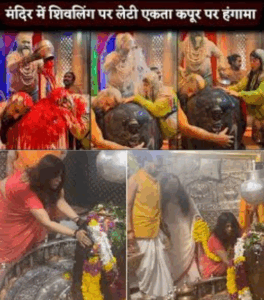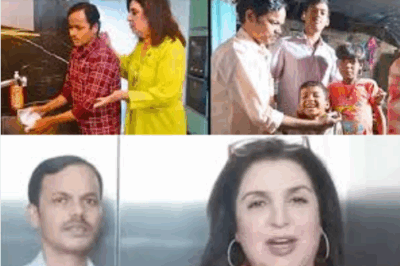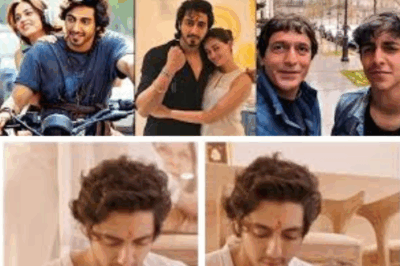Ekta Kapoor Lay Down On Shivling During Rudrabhishek Sparks Outrage As Video Goes Viral
A storm has erupted around television and film producer Ekta Kapoor after a video capturing her on top of a Shiva Lingam went viral online. The footage shows Ekta receiving Rudrabhishek, a sacred Vedic ritual, by lying down and clutching the Lingam while priests pour sacred substances like milk and ash over the deity. Though she briefly steps away, seemingly struggling for breath, she soon returns, pressing herself once more against the Lingam. The incident took place amid the holy month of Sawan, traditionally dedicated to Lord Shiva, sparking fierce debate and widespread outrage.
Sawan is revered across India as a time for divine devotion, prayer, and respect toward Lord Shiva. The sight of Ekta pressed tightly against the Lingam has triggered an uproar among devotees and religious leaders alike. Some commentators rushed to social media, accusing her of treating holy rituals like a promotional stunt fueled by money. One user wrote, “People think they can buy God with money,” while another labeled her behavior “self-purified abhishek,” questioning her motives. Others saw the move as blatant hypocrisy, lamenting that “God is different for the rich and different for the poor in India.” These scathing criticisms reflect a brewing sense of injustice, with many believers feeling that the sanctity of the ritual has been tarnished by celebrity overreach.
Ekta Kapoor stands as a powerful figure in the Indian television and film industry. Known for launching countless hits and shaping modern serial storytelling, she holds both creative influence and public visibility. Her career has long drawn attention, but this moment places her at the center of a culturally sensitive storm. Supporters see no harm in her embrace of spiritual practice, while detractors feel that her behavior represents a troubling breach of decorum and reverence.
Central to the controversy is the symbolism of the Shiva Lingam itself. In Hindu worship, the Lingam represents divine energy and cosmic creation. Rudrabhishek, the act of bathing the Lingam with milk, water, honey, and cow dung, holds great spiritual weight. It is a sacred ritual performed with solemn intent, often to honor Lord Shiva and seek blessings. Observers argue that Ekta’s decision to physically lay on the Lingam—rather than offer prayers from a respectful distance—betrays the quiet dignity that ritual requires.
Some critics warn that this event undermines communal norms. Temples are spaces that expect humility and restraint, with specific rules to ensure the respect of the divine. Many are questioning whether Ekta’s actions violated temple protocol or merely overstepped cultural expectations. Others wonder why her moment of press attention was left unmoderated until the video surfaced online.

Yet Ekta herself has not issued any public statement explaining her intentions. In the absence of clarification, speculation runs rampant. A narrative has emerged suggesting that she may have misinterpreted the ritual, mistaking her embrace as a deeply personal expression of devotion. Alternatively, some critics posit that real or rumored conflicts around money or nepotism may have sparked backlash unrelated to religious impropriety.
Her silence has done little to quell the storm. In an age when celebrities are expected to respond quickly to controversy, the lack of an apology or explanation adds fuel to the public reaction. While some fans have leaped to her defense, asserting that “holiness is personal” or warning against quick judgments, many maintain that public figures hold a responsibility to uphold tradition and community values—especially when performing sacred acts.
This controversy sheds light on broader cultural dynamics in India, where religion, celebrity, and social media intersect powerfully. On one hand, social media empowers devotees to immediately call out behavior that deviates from expected norms. On the other, it can amplify outrage, driving the conversation beyond rational debate into moral policing or performative virtue.
Inside temple management circles, there are concerns about protocols. Many priests follow strict rules about touch, dress, and offering. Unauthorized physical contact with a Lingam could be seen as desecration under certain interpretations. Yet temples vary widely—from large public spaces with designated open access to traditional community shrines with tight restrictions.
A senior temple authority in Varanasi acknowledged, “Shivling is a symbol, not an object for display. Rudrabhishek calls for utmost respect and understanding of boundaries.” While no one can confirm which temple Ekta visited, her actions have rattled religious custodians nationwide, prompting renewed discussion about enforcing respectful behavior even in open shrines.
Religious scholars also note the tension between personal devotion and collective sensibility. Spiritual practice is deeply individual, but public displays can influence others’ perceptions. “Devotion is heartfelt. But when a public figure acts in an unorthodox way in a sacred space, it becomes a public matter,” observes scholar Dr. Ananya Roy. She warns that without careful observance, such incidents erode trust between traditional stewards and aspirational followers looking to find spiritual meaning in ritual.
For Ekta Kapoor, this situation blends her identity as a cultural influencer with her responsibilities as a public persona. Her career has made her one of the richest women in entertainment, translating creative success into political clout and financial resources. Now, however, spiritual sincerity and appearances of self-promotion clash in the minds of viewers.
Some analysts suggest this backlash could affect her production house. Political leaders in regions where television serials carry major influence have in the past responded to moral controversies with censorship demands. A temple-related event—especially during Sawan—touches nerves. Opposition voices might call for censure from religious groups or entertainment industry bodies.
Ekta’s best path forward may be transparency. An explanation of her motivations—whether spiritual, personal, or symbolic—might allow her to reclaim the narrative. Many important leaders have issued clarifying messages after controversies, while still affirming their faith. A heartfelt apology or statement of devotion might placate critics while preserving her spiritual claim.
Timing is critical. If Ekta continues ignoring queries, the controversy risks escalating. Temple authorities or local religious leaders may step in with formal statements. Online campaigns might initiate temple etiquette guidelines, ironically reinforcing boundaries she unintentionally broke. Without her voice, she leaves space for misinformation to fester.

Conversely, fans backing her right to personal devotion may see continued silence as symbolic of resilience. They might tweet #LetEktaPray, insisting routine religious freedom should tolerate diverse expressions of faith—even when they appear unconventional. With polarization across many debates in India, this may become another point of identity politics rather than religious discourse.
The outcome depends largely on how Ekta navigates this moment. Does she clarify that her gesture was an honest impulse born of love for Shiva? Will she kneel at the threshold of social convention and offer an apology for unintended offense? Or will she choose to refrain from further comment, letting the viral images speak for themselves?
There’s a layer of unpredictability too. As a creative leader, Ekta specializes in crafting compelling narratives and directing emotional arcs. Would she choose to adopt this real-life controversy into her work—a television episode about public shaming, media outrage, and personal redemption? The irony would be striking, yet potentially cathartic.
Meanwhile, amidst this maelstrom, the ritual itself—the Rudrabhishek—continues to be performed in thousands of temples across the country. Millions of worshippers channel their inner devotion without seeking attention, leaning in quietly, hands raised in prayer rather than clutching sacred stones. For them, the spiritual act remains profound and dignified. The contrast between this quiet devotion and Ekta’s dramatic interpretation has reignited reflection on ceremonies we hold dear.
Beyond the entertainment sphere, this event stands as a reminder of how faith, culture, and celebrity collide in India’s public square. It underscores the responsibility that artistic voices hold—especially when stepping into religious spaces during holy periods. Deeply personal choices can become deeply political, shaped and judged by millions.
In the end, Ekta Kapoor’s actions stir a broader conversation about respect, boundaries, and spiritual authenticity. They challenge both stars and audiences to ask: what does it mean to worship? Is the performative optimism we see online an extension of devotion, or a misstep born of blurred lines between self-expression and spectacle?
As the controversy unfolds, one truth remains clear: in a society where faith and fame share the stage, even a single gesture can ignite a national dialogue. Whether Ekta Kapoor emerges from this episode with her reputation intact depends not on the initial video, but on her next steps—how she chooses to honor both her heart and her heritage in the court of public opinion.
Play video :
https://youtu.be/uhk1PuKevYc?si=_t5FYrVU6VX2E080
News
Urfi Javed Face Swollen After Lips, Causing Side Effects and Negative Impact
Urfi Javed Face Swollen After Lips, Causing Side Effects and Negative Impact Urfi Javed, known widely for her bold fashion…
Farah Khan Shifts Her Cook Dilip’s Children Into English Medium School
Farah Khan Shifts Her Cook Dilip’s Children Into English Medium School In a world driven by celebrity headlines, paparazzi flashes,…
Who Is Ahaan Panday? Who Are Saiyaara Star Ahaan’s Parents?
Who Is Ahaan Panday? Who Are Saiyaara Star Ahaan’s Parents? Ahaan Panday: The Rising Star Everyone’s Talking About—But Not Everyone…
Katrina Kaif’s Father-In-Law Sham Kaushal Wanted To Jump From 3rd Floor
Katrina Kaif’s Father-In-Law Sham Kaushal Wanted To Jump From 3rd Floor Shyam Kaushal, Katrina Kaif’s father-in-law and Vicky Kaushal’s father,…
Hansika Motwani and Sohael Khaturiya Heading For Divorce After 2 years Of Wedding?
Hansika Motwani and Sohael Khaturiya Heading For Divorce After 2 years Of Wedding? Bollywood actress Hansika Motwani, once known for…
Did Kapil Sharma again attacked with Gun Shot? Life Thread Incident Stopped Great Kapil Show Shoot
Did Kapil Sharma again attacked with Gun Shot? Life Thread Incident Stopped Great Kapil Show Shoot . . . Gunfire…
End of content
No more pages to load












